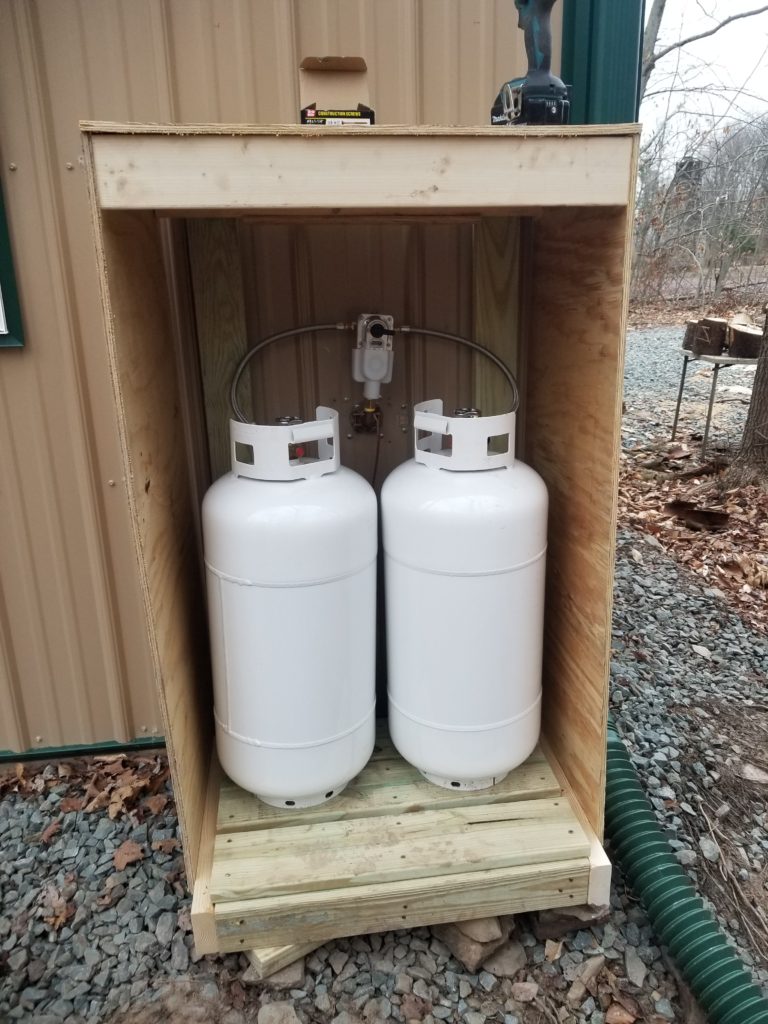What is it with this little house and water where it shouldn’t be? First it was rain coming in through the vent for the water heater. I fixed that. Then there was water coming in through a defect in the flashing around the skylight (remember Demon Cat?). I fixed that.
Then there was water coming in through the threshold of the front door. I fixed that. Then that wasn’t fixed after all, so I fixed it again.
Then there was condensation on the skylights and other windows causing mold. I fixed those (HRV) best I could, but there’s still some of that as ongoing maintenance. I think that’s just the way it’s gotta be for those. Not a huge problem – just add it to the list of weekly chores – take out the trash, treat windows for mold. If that’s what it takes, so be it.
Then I find the door threshold is still getting wet. It turns out that cold air is coming in from below it and condensing the humidity in the house (which is less than it was 70 now down to 50% rh) and moistening the subfloor just a little. But also when it rains or snows, I get a bunch more water from the threshold. I suspected the threshold cap wasn’t quite angled right, causing some ingress rather than shedding of water that impinged on it. I had a moderately temperate day (>40F) recently and took a closer look.
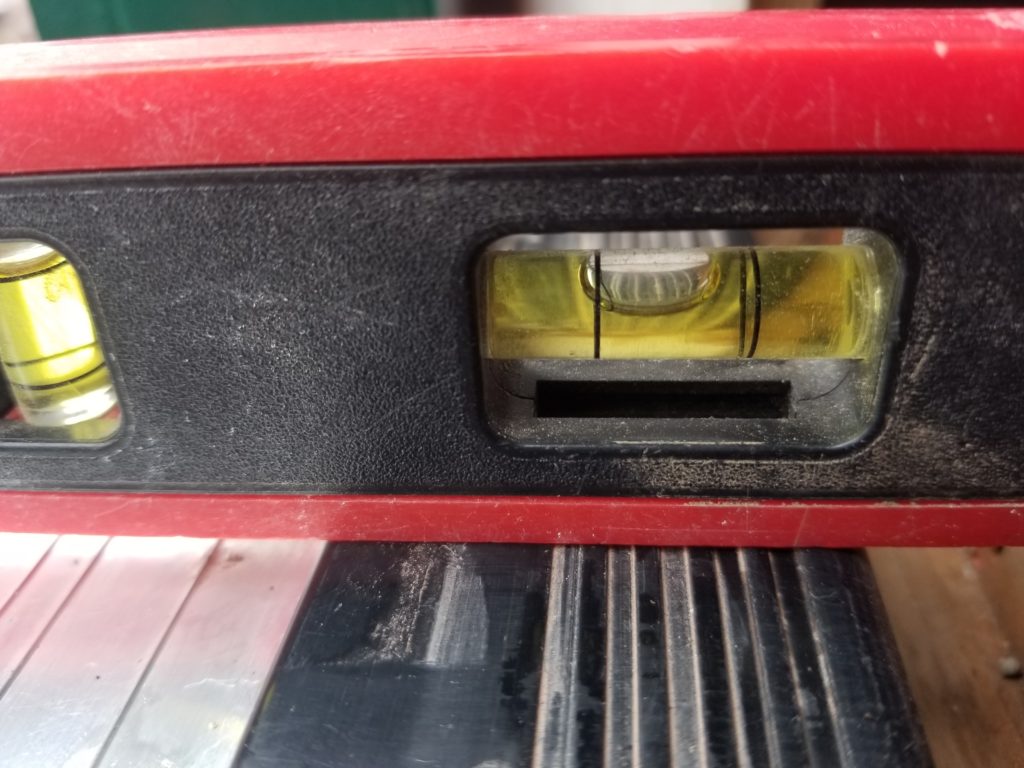
While the aluminum plate (far left) is nicely sloped away, the level is telling me the threshold cap (black plastic) is actually tilted into the house just a tiny bit. No bueno! I suspected that might also be an issue and this proves it. I knew the back of the cap was unsupported — it looks like it’s meant to rest on the finished floor but my finished floor doesn’t come that close — so what I need was some support there. Okay, I did that.
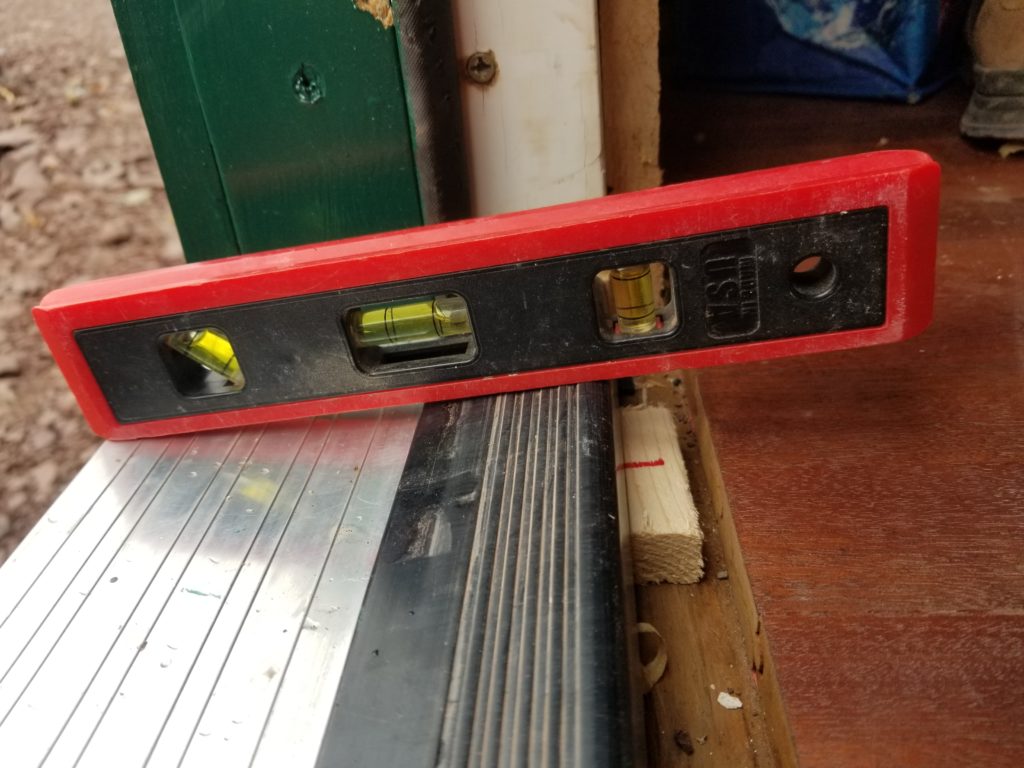
Now the cap is really slowed away from the house. Any water that touches it will want to flow onto the aluminum plate, which is also sloped (more gently, but still) away. Excellent. Problem solved, right?
Well, maybe. Lemme take a gallon of water and pour it onto the door from outside to see what happens inside. But I can’t close the door. It seems the shimming of the threshold cap has shifted the door system, too, or otherwise made one edge of the door bind against the jamb (not the cap!) in a way it didn’t before. This door is very heavy – probably about 100# – it is solid wood and nearly 2″ thick – and anyhow due to some poor planning, is mounted with captive-pin hinges, so even if I wanted to dismount the door for refinement, it’s an even bigger problem to do that than it already was. Okay, then, can I refine the door in place? Yup. I have the technology.
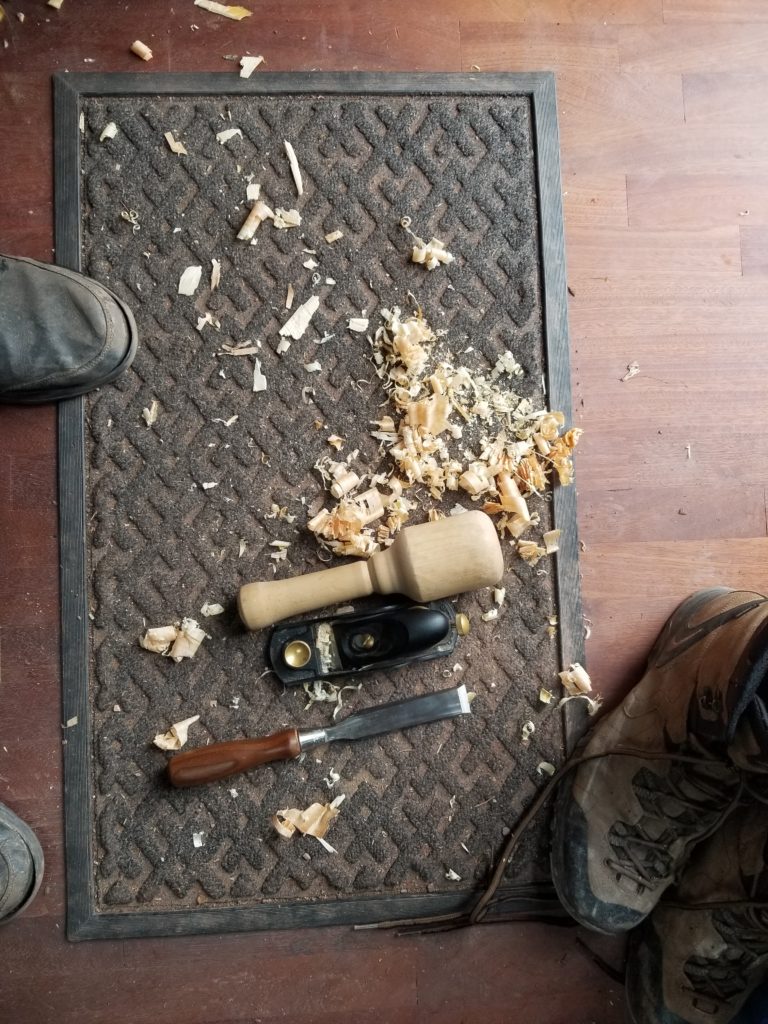
And so it was done. Now that the threshold and the threshold cap are adjusted, how are things? Well, there seems to be a void in the weather stripping that lets a tiny bit of water through anyhow. I’m not convinced there’s no way water somehow gets behind the cap and under it, too. Or around and under the plate. Or something. And for sure there’s condensation happening when a little bit of cold air comes under the door and hits my new door sweep (a rubber blade, essentially, at the bottom inside of the door, meant to keep out this exact draft). A little bit of water condenses on the sweep itself! Gah! I tried to put something on the bottom bottom of the door to keep out the draft but that just got crushed and destroyed – perhaps it was slightly too big? Dunno. And I really don’t want to deal with it in the winter (now). Can I tolerate a tiny bit of moisture for the whole season? Um… it’s not great. Will it be an actual problem? Possibly? Probably? Maybe not? I honestly just don’t know. I also don’t know what I will do about it, either, other than totally re-do the door system, paying a lot more attention to the fit and the weather stripping. That’s an all-day project most likely – one I’m not at all keen to do in winter, nevermind my workshop still isn’t ready for that kind of thing. Not by a long shot.
Speaking of workshop – remember how excited I was to get the table saw liberated from the moving boxes, in hopes of actually using it? Well, it turns out that of the four different kinds of sockets my generator has, none of them is a NEMA 6-15, so I can’t actually just plug it in! However, I do note that the generator came with this dongle that connects the L14-30 to a pair of standard duplex 120V outlets. I’ll bet those outlets are one each on different legs of the 240V output, presenting as 120V each. If that’s indeed the case, the voltage across the hot terminals of opposing outlets will be 240V and they should share a neutral. I will confirm this. And when I do, I will create a fun frankenstein cord that has two 120V plugs, one destined for each side of the dongle, to get 240V from it to run my table saw until I can get a more appropriate power feed happening, which won’t be for a while.
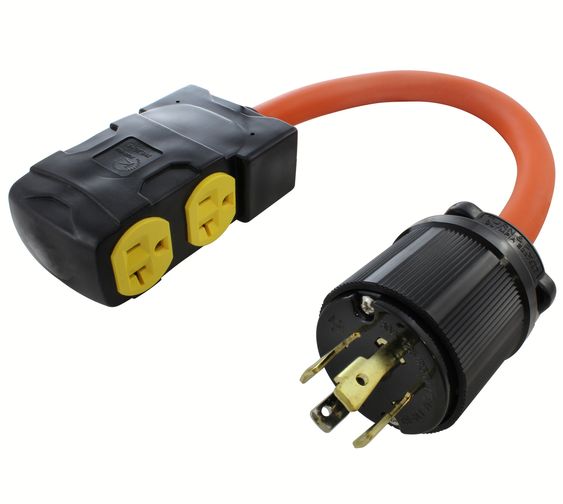
Then I find this especially curious mystery: a small pool of water around a bolt, with no trail showing how it got there, no splashes suggesting it came from above. This bolt is behind the bath tub in a dark corner – not somewhere I routinely look. I don’t even remember why I was looking back there – oh yes I do – there was some moisture in the front of this scene and I was wondering if it came from back there.
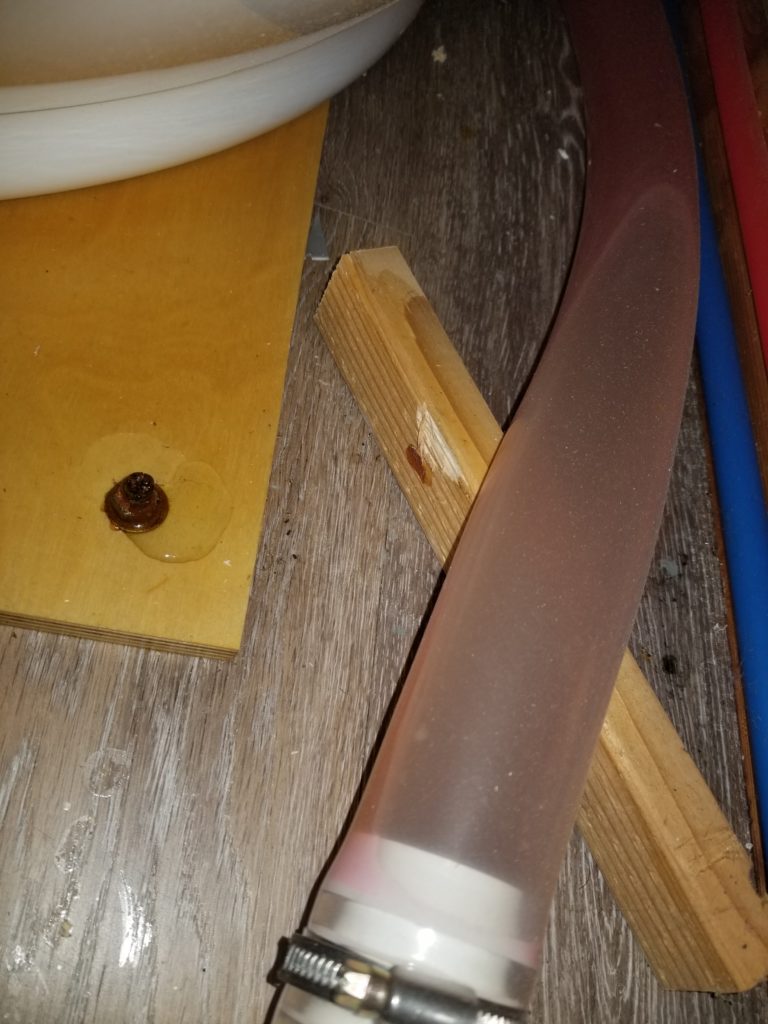
I noted with interest that the bolt was all rusty, as if it had gotten wet like this a lot. Was there a leak in the clear hose? No. The red & blue PEX pipes? No. Anything from above? No. So question 1: how does water appear on top of that plywood, without a rivulet or a splash? The answer came from observing that there was a thin sheen of water on the floor, as well. I think what happens is that water gets under the plywood and finds its way to the bolt, where capillary action carries it up the bolt threads til it emerges at the washer and spreads out on the top of the plywood. Sneaky! Question 2: what is the origin of this water on the floor?
That’s a good question. There are a few possibilities. I already ruled out direct leaks from the plumbing in the area, both at ground level and above. It’s more like seepage than a sprung pipe. I suspect that, like demon cat, this water is actually moving behind the cedar paneling, coming from above, and emerging at the floor, where the paneling ends. It then tracks across the floor to the plywood, gets sucked under that by capillary action, where it also is drawn up at the bolt, making this little puddle and working its rustogenic magic. If the water is in the wall, how is it getting there? I can think of three ways.
Way 1 – some water utility in the loft is leaking and tracking into the wall and down into the T.H.R.O.N.E. Room. I went up to the loft and felt around for wet carpet – nothing. Wet connections and fittings – nothing. Sweat from the freshwater tank – nothing. Good! Glad to know it, but sad not to find something I can tighten.
Way 2- the in-ceiling gray water tank is leaking, tracking behind the ceiling mural, behind the wall, and down. There’s no good way to test that, but there is a so-so way to test it. I have drained the gray water tank and plugged all the drains that lead to it so the tank is and will stay empty as of mid-afternoon and until tomorrow morning. I have twice already gone to the wall where the seepage happens and mopped it up. If what’s coming is simply residual from the tank, it should end soon and certainly not continue into the morning. If there was so much water that it would keep coming when the tank was empty (though wet), I’d expect the floor to be soaked, not seeped.
Way 3 – a defect in the wall or the roof is letting water in somehow. It probably isn’t the wall, since the interior of the wall is filled with foam insulation that’s impervious to water. But if water got behind the foam somehow, it could come into the room behind the paneling. It has been raining and snowing here, so there’s plenty of opportunity for outside water to be presented to the house. I did a cursory inspection of the exterior from ground level and didn’t find anything glaring, but that doesn’t mean anything other than there wasn’t anything glaring. Unlike demon cat, who appeared in a direct line from the edge of a skylight, there’s nothing interesting anywhere near this seepage site. Of course, water could be coming in from somewhere else entirely behind the wall and tracking across, then coming down and out because that just happens to be a low spot or an easy path for the water.
Short of tearing the walls apart, there’s no good way to investigate this and I am not at all keen to tear the wall apart, for lots of very good reasons, not the least of which is I’d have to remove the bathtub (a very big deal – remember how much trouble it was to get it in there?) and then repair the wall (ditto). And if I find that water is coming from “up”, I’d have to keep digging out the wall to find the source. And the paneling is glued to what’s behind it. So not so much with the easy removal. And then there’s that beautiful tile inlay I spent so long creating, which would not survive this. No, I really, really, really don’t want to break open that wall.
If I can prove it’s the gray water tank, that doesn’t help me much unless I can mitigate the issue by not accumulating water in that tank. My original reason for there being such a tank was I thought there was a likelihood of the drain line freezing in winter if allowed to simply accommodate trickles of water, so sending 10 – 40 accumulated gallons of tepid water at a time every few days seemed like a better answer. That would be enough to thaw any thin icing that happened and anyway, having a few hundred pounds of water in storage is good for thermal equilibrium in the house, too. This seemed like a good idea. Looking at how the rest of the gray water system actually wound up being built, I am a lot less concerned that it will ice up. The water that flows out is 50 – 80F and doesn’t stay in the pipes long at all. Chances are it completely drains out, actually, to the point that there isn’t standing water that even could freeze. Maybe a tiny coating of ice might form, but a totally occluded pipe? Nah, that’s just unreasonable. And if I’m really worried about it, I can just flush some hot (130F) water down the drain every now and then to clear what might be there. Am I rationalizing because I don’t want to open that wall. YOU BET I AM.
I did leak-test that gray water tank after I finished the utility loft. I filled it up and left it for a while and nothing happened. Did I actually check the floor during that test? How long did I wait? You know, I think I only looked at the ceiling for drips around the seams and edges and I think it was just an hour or so. I don’t think I left it for hours and I can’t imagine I looked at the floor. If it takes a few hours for the seepage to make its way down the wall, I’d have missed it entirely. Or if the damage is new, perhaps caused by extreme jostling that happened during delivery of the house on site, even a comprehensive test from before that wouldn’t show what happened after that.
So what’s next? What’s next is the rain & snow stops here. I suspend use of the gray water tank for 12h, and hope to see that the seepage stops. If it does, I have a dry, steady state system I can experiment with. I will close the drain valve for the tank and add a few gallons to it and then wait all day for the seepage to return. If it does, I can probably blame the tank and then I can hope that letting the tank just flow out instead of hold will be the answer. If it doesn’t, the water is probably coming from outside somewhere, and that, dear reader, will be very difficult and likely dishearteningly invasive/destructive to diagnose.
Water. Why do you vex me so?
I did a bit more poking around in the T.H.R.O.N.E. Room behind the tub and elsewhere. Besides realizing I need to vacuum out some dust from under here, I found something very interesting indeed. Observe the droplets on the wall under and actually also a tiny bit above the blue PEX line. The floor beneath there is a bit wet, too. But it’s the droplets on the wall that’s most interesting in this scene.
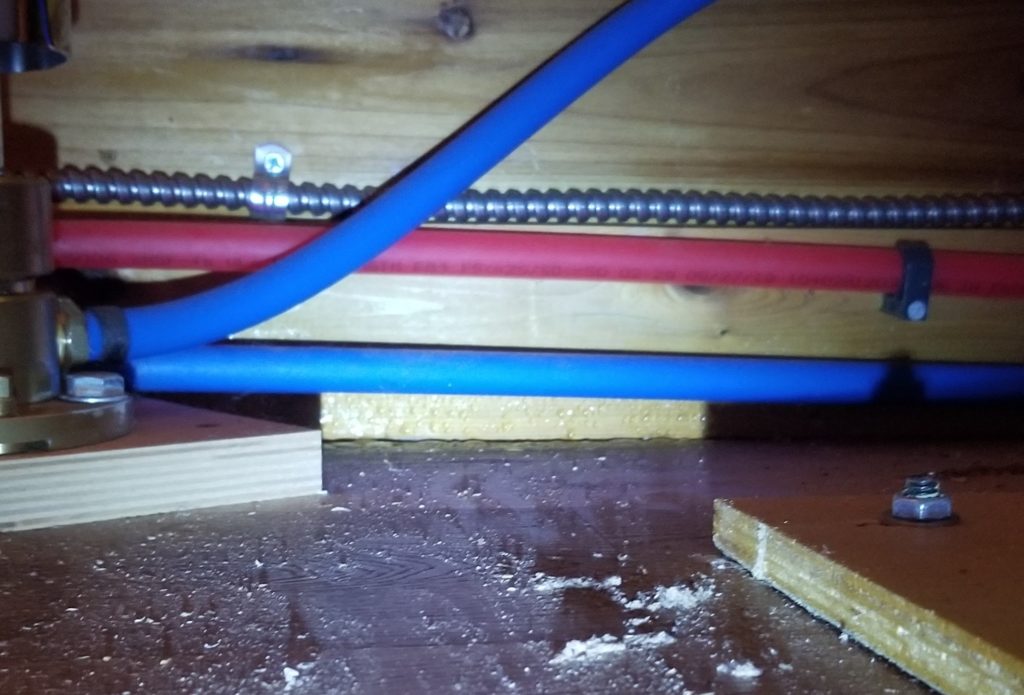
I looked in some other cool spaces, like under the sink where the big bottle of dish soap lives (there’s a pump that brings the soap up to the sink deck). The bottle had droplets all over it. There were droplets on the bottom of the entry door. There was some surface moisture in one of the cargo bays next to the T.H.R.O.N.E. There were droplets on the inside of the door jamb. What do all these things have in common? They are places heat doesn’t reach. I don’t think I have a leak at all. I think I have a massive condensation problem. Water doesn’t appear in droplets on a twice-varnished surface (picture above) because of a leak behind it. Water doesn’t appear on the surface of my dish soap bottle, which is not within range of any source of water other than the air, because of a leak. I think the bottom of the walls, which are essentially solid wood from inside to out (the paneling, the sub-wall, the bottom plate of the stud wall, the outside sheathing, then the outside cedar cladding), and are therefore somewhat less insulating than the bays between the studs, which are filled with foam, and are at the very lowest part of the house, where heat reaches last and further adjacent to the floor, which while also insulated below, not nearly as well as the walls, are simply being cold enough to condense my 50% rh interior air and making things wet. I have two instruments in here, actually, and they vary wildly about what they say the humidity is. One says 52% and the other says 68% which I think is wrong based on my comfort level (and cheap digital hygrometers aren’t necessarily all that reliable, especially ones that have been out in the world a bit, as that one reading 68% has been). Still, even 52% can condense if there’s a chill. And the floor of the T.H.R.O.N.E. room, furthest from the heat source, air circulation blocked by the tub, on the north wall, for that matter, not even getting warmth from the sun during the day… yeah, I don’t think I have a leak at all. I think I have an acute condensation problem. That’s “good” in that I have nothing to destroy to only discover the problem isn’t in the walls or the roof, but it does mean I need to more strongly mitigate humidity in here or somehow manage to better warm those cold spots so they don’t condense. The HRV may be helping a little, but it hasn’t really dried out the place like I hoped.
Hmmmm. Why not just use a dehumidifier, you might quite reasonably ask. Well, they use a bunch of energy and I don’t think I have the energy budget to support one, that’s why. And they’re noisy, though I could probably get accustomed to the noise. I do actually have a dehumidifier I’m not currently using. I could try it – hook it up to my energy meter to see what it costs me for real and set it for very dry to see if it helps. I don’t even have an outlet where I’d want to put it, but I can run an extension cord for the test. If it works, it should be pretty dramatic in a day or so.
In other news, I made incremental progress on the W.O.G.’s propane deck. Now it has two sides and a roof and is considerably more level than it was when I started. I still need some kind of front door for it – I bought the hinges recently, so that’ll happen soon. Remember, this is just temporary for the winter anyway. I’ll build something more robust (including painting it!) when the weather’s nice and I’m not in a hurry. And yes, the regulator is cocked to the side a little. Nothing bad happens because of that and it’s a new leak test if I move it and it being 5 degrees of level really doesn’t matter to anybody except my own highly bruised sense of perfection.
